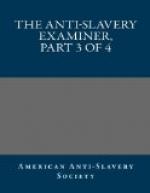“In a short time after I was put upon the plantation, there was but little difference between me and the slaves, except being white, I ate at the master’s table. The slaves were my companions in misery, and I well learned their condition, both in the house and field. Their dwellings are log huts, from ten to twelve feet square; often without windows, doors or floors. They have neither chairs, tables or bedsteads. These huts are occupied by eight, ten or twelve persons each. Their bedding generally consists of two old blankets. Many of them sleep night after night sitting upon their blocks or stools; others sleep in the open air. Our task was appointed, and from dawn till dark all must bend to their work. Their meals were taken without knife or plate, dish or spoon. Their food was corn pone, prepared in the coarsest manner, with a small allowance of meat. Their meals in the field were taken from the hands of the carrier, wherever he found them, with no more ceremony than in the feeding of swine. My uncle was his own overseer. For punishing in the field, he preferred a large hickory stick; and wo to him whose work was not done to please him, for the hickory was used upon our heads as remorselessly as if we had been mad dogs. I was often the object of his fury, and shall bear the marks of it on my body till I die. Such was my suffering and degradation, that at the end of five years, I hardly dared to say I was free. When thinning cotton, we went mostly on our knees. One day, while thus engaged, my uncle found my row behind; and, by way of admonition, gave me a few blows with his hickory, the marks of which I carried for weeks. Often I followed the example of the fugitive slaves, and betook myself to the mountains; but hunger and fear drove me back, to share with the wretched slave his toil and stripes. But I have talked enough about my own bondage; I will now relate a few facts, showing the condition of the slaves generally.




